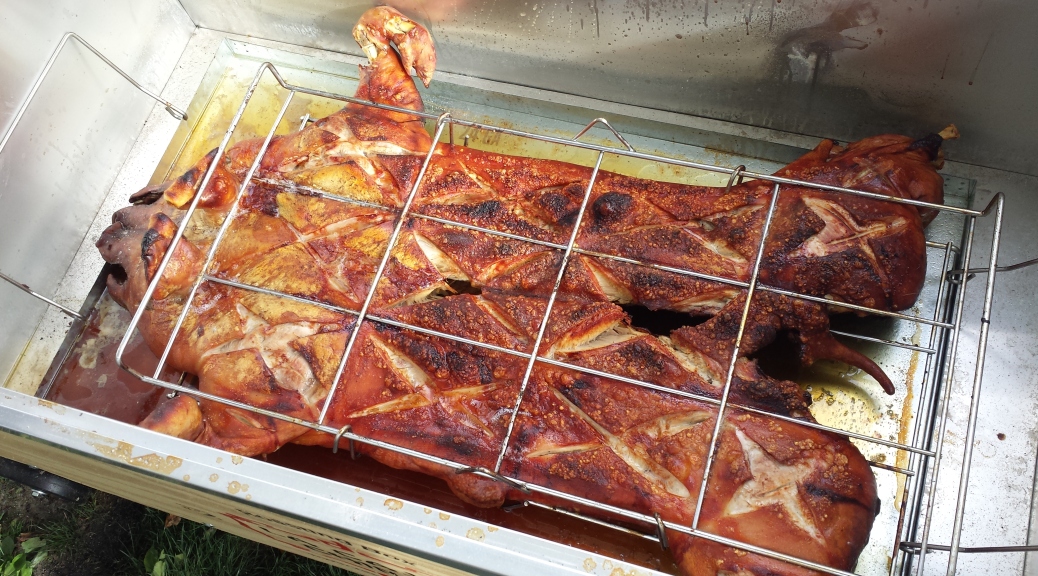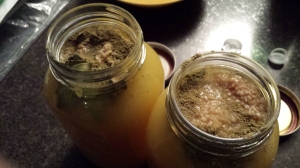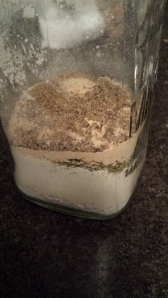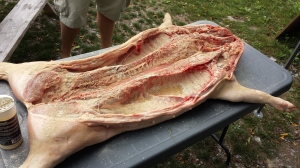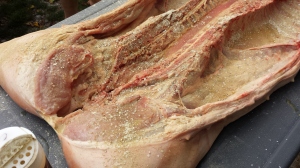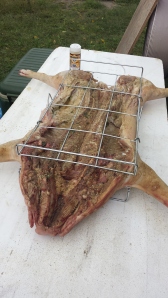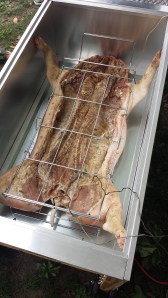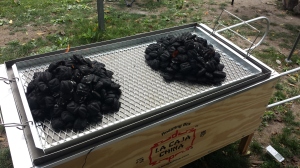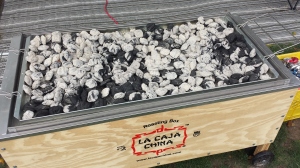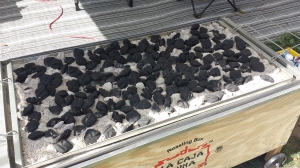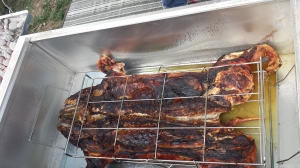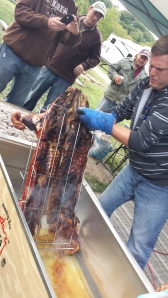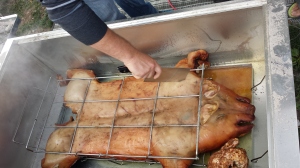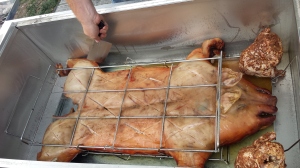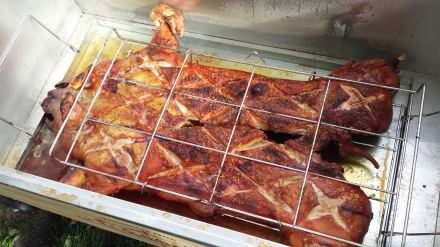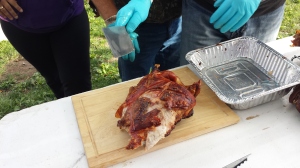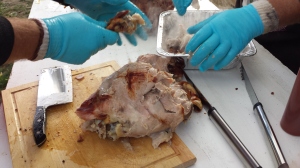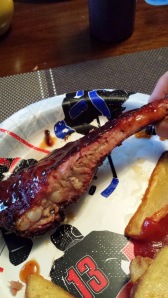Whole Hog…The mother of all BBQ feats. The task that makes even the most confident backyard warrior think twice. I decided it was time. I decided I was ready. The results were better than I hoped for.
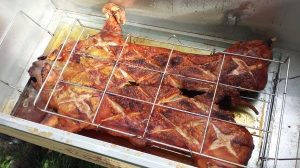 First, let me start by thanking some people. These people were a big help with the cooking of this pig. They helped me wrangle the pig, get the pig in the racks, move the grates and pans around, pull the pig apart once it was cooked and of course, taste test it once it was done. A big thanks to Casey, Joel, Uncle Mark, Chad, Shane, Matt, Amy, Jill, Sarah, Carissa and everyone that was on hand to help put the rest of the shindig together.
First, let me start by thanking some people. These people were a big help with the cooking of this pig. They helped me wrangle the pig, get the pig in the racks, move the grates and pans around, pull the pig apart once it was cooked and of course, taste test it once it was done. A big thanks to Casey, Joel, Uncle Mark, Chad, Shane, Matt, Amy, Jill, Sarah, Carissa and everyone that was on hand to help put the rest of the shindig together.
As I posted earlier on this blog I was aiming to get my hands on a La Caja China Roasting Box…well, I got one.
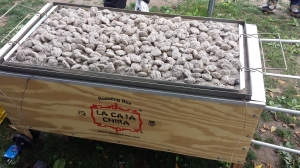 I went with Model #2. It is the bigger box and can handle larger pigs. Go big or go home, right?
I went with Model #2. It is the bigger box and can handle larger pigs. Go big or go home, right?
I ordered the pig from Kohns in London. I asked for a 50lb pig, dressed weight, butterflied open. “Dressed Weight” simply means all the guts and nasty bits are removed and you have a clean carcass. “Butterflied” means they split the backbone for me so that the pig will lay flat. When I arrived to pick up the pig it was 52lbs and they split it perfectly for me while I was there. I highly recommend you become friends with your butcher. I highly recommend Kohns. Always great service and quality.
My buddy Casey was with me when we picked it up. We put it in a big cooler with some blocks of ice to keep it cool.
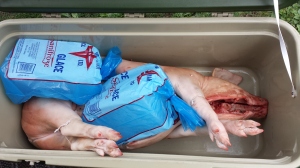 The day before I had prepared the injection I was planning to use and the dry rub for the pig. Because this was my first attempt and because of the hours and hours of videos I watched on Youtube regarding cooking a pig I decided to stick to a tried and true approach. I used the injection and rub suggested by La Caja China, the makers of the box. It is a traditional Cuban Mojo Criollo Injection and an Adobo Seasoning mix. Both credited to Roberto Guerra of La Caja China. I didn’t change a thing.
The day before I had prepared the injection I was planning to use and the dry rub for the pig. Because this was my first attempt and because of the hours and hours of videos I watched on Youtube regarding cooking a pig I decided to stick to a tried and true approach. I used the injection and rub suggested by La Caja China, the makers of the box. It is a traditional Cuban Mojo Criollo Injection and an Adobo Seasoning mix. Both credited to Roberto Guerra of La Caja China. I didn’t change a thing.
Mojo Criollo
Ingredients
- 3 heads garlic, peeled
- 1 teaspoon whole black peppercorns
- 2 teaspoons coarse salt
- 1 1/2 cups freshly squeezed sour orange juice (or 1 cup freshly squeezed orange juice mixed with 1/2 cup freshly squeezed lemon juice)
- 1/2 cup pineapple juice
- 2 teaspoons oregano
- 1 teaspoon ground cumin
- 1 teaspoon ground bay leaves
Directions
-
Place garlic, peppercorns, and salt in a large mortar and grind with a pestle to form a paste. Stir in sour orange and pineapple juice. Add oregano, cumin, and bay leaves; stir to combine. Let stand at least 1 hour before using.
Adobo Seasoning
Ingredients
- 1/2 cup coarse salt
- 1/2 cup garlic powder
- 1/4 cup onion powder
- 1/4 cup ground oregano
- 4 teaspoons ground bay leaves
- 1 tablespoon ground cumin
- 1/2 teaspoon freshly ground black pepper
Directions
-
Mix together all ingredients in an airtight container; cover and let stand at least 12 hours before using.
The day before we planned to cook the pig I injected the pig all over but focused on the hams (back legs), shoulders (front legs), loin (attached to the ribs) and the belly meat (the..well…belly of course).
It’s worth noting that I strained the injection before I used it so any large chunks wouldn’t plug up the needle on the injector.
After injecting the pig I coated both the skin side and the open side with the seasoning blend.
It was back into the cooler at this point for the night for the injection and spice blend to do their work.
The next morning the pig was brought out about an hour before we planned to cook it to come to room temperature as suggested in the cooking instructions for the pig. Notice in the picture below the difference in colour of the meat. The seasoning and injection did it’s job.
The pig was then put into the racks that came with the roasting box and closed using the “S” hooks provided. Here is a tip for you; this is not a 1 person job. It took 3 of us to get the hooks in place. Two people pressing down on the side of the rack and one person placing the hooks.
Once we FINALLY had the pig in the racks it was time to enter the roasting box.
You will notice there are some wires coming out of the pig. We attached a couple meat probes in the pig to monitor the progress as it cooked. Next time I won’t bother. If anything, all the probes did was add stress where none was needed. The directions they give you right on the side of the box are all you need. I followed them exactly and am glad I did.

We used the instructions for a 51 to 100lbs. pig. We did this because you will notice that the pig weights on the box are based on “Live Weight” not “dressed”. Live weight is the total weight of the pig before any cleaning or butchery is done. Because our pig was 52lbs dressed, it was easily 60-70lbs live weight.
Once the pig is in the box, place the top charcoal grate and ash pan to seal the box. We started with the recommended 18lbs of charcoal, placed in two piles to light. Here is the hardest part of the cook. You can NOT lift that lid. For no reason. Not even for a second for a quick peak. JUST DON’T DO IT!
We doused in lighter fluid and let them burn until almost all of the coals were turning grey, meaning they were on fire and burning. This took about 20 minutes. I then spread the coals out evenly over the top of the box and began my timer.
The instruction on the side of the box calls for adding fresh charcoal every hour. Based on the weight of our pig I added 10lbs of charcoal after 1 hour and then another 10lbs after the second hour.
You do not need to worry about starting the charcoal in a chimney or anything like that. The already lit coals will ignite the fresh coals. Make sure you follow the amounts on the side of the box and spread it out evenly when you add it.
The next step was to add 12 lbs of charcoal 30 minutes after the second 10lbs of charcoal was added.
30 minutes after the 12lbs were added it is time to finally see what the pig looks like. The instructions call for you to remove the ash from the ash collection pan. This will remove all the ash which is actually reducing the amount of heat the pig could receive. By removing this ash we will get a very high temperature in the box which we need at this point. We will be turning the pig over to crisp the skin. High heat is definitely needed for this.
Lift the charcoal grate and shake to remove the ash.
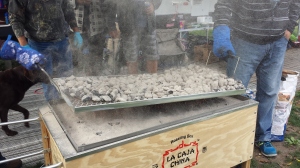 Place the charcoal grate on the handles, remove the ash pan and dump it out.
Place the charcoal grate on the handles, remove the ash pan and dump it out.
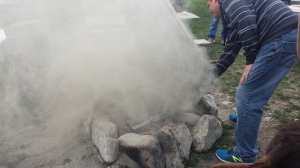 Here is a tip we learned. Make sure that when you shake the charcoal pan that you do it gently and try to keep things that can light on fire away from the box.
Here is a tip we learned. Make sure that when you shake the charcoal pan that you do it gently and try to keep things that can light on fire away from the box.
Now, the moment you were waiting for. Your first peak into the box.
As you can see, the pig is nicely roasted on this side at this point. There are areas that look dark on this picture, they weren’t burnt. They were actually nice and crispy and tasted great.
Time to flip the pig. Grab the rack at one end and lift. Let the bottom slide to the opposite side of the box from where it originally was placed then lower the top end back down. This can easily be done with one person.
As you can see from the picture below, the skin side is seriously missing some colour.
Take a knife and score the skin in an “X” pattern in each of the rectangles created by the rack. Be careful to not cut too deeply. We just want to score the skin, not the meat.
We decided to try 2 beer can chickens in the box at this point just for fun. They turned out awesome.
Put the ash pan back on the box and put the charcoal grate back in place. It should take between 30-45 minutes to crisp the skin. Check the skin after 30 minutes. If it is not done to your liking, cook for another 15 minutes.
Here is what our pig looked like.
Take the pig out of the cooker, remove it from the rack and let rest for about 30 minutes.
You will need a heat resistant pair of gloves for the next part. Separate the pig and pull the meat from the carcass and serve. The meat will be so tender you will not need any type of knives or tools for this. The only thing I used was a cleaver to make cutting up the crispy skin easier. The skin was awesome. Glass shatteringly crispy and tasty.
Start to finish the pig took 4 hours and 45 minutes. It was relatively easy to do and everyone loved the pig. I would change absolutely nothing.
Serve with some nice salads, buns to make sandwiches, mustard and sauces and enjoy!
MD

